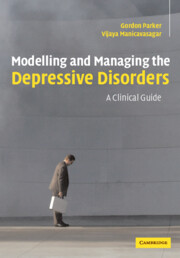Book contents
- Frontmatter
- Contents
- Acknowledgements
- Introduction
- Part I The current model for depressive disorders and its impact on clinical management
- Part II The diagnosis and management of melancholic and psychotic depression
- Part III An introduction to non-melancholic depression
- Part IV Modelling and managing the non-melancholic depressive disorders
- 13 Acute stress-related non-melancholic depression
- 14 Acute stress-related non-melancholic depression: ‘key and lock’ model
- 15 Chronic stress-related non-melancholic depression
- 16 The perfectionist personality style and non-melancholic depression
- 17 Irritability and non-melancholic depression
- 18 Anxious worrying and non-melancholic depression
- 19 Social avoidance and non-melancholic depression
- 20 Personal reserve and non-melancholic depression
- 21 Rejection sensitivity and non-melancholic depression
- 22 Self-focused personality style and non-melancholic depression
- 23 Self-criticism and non-melancholic depression
- 24 Natural and alternative treatments for non-melancholic depression
- Appendix 1 The DMI-18 and the DMI-10
- Appendix 2 The CORE system of measuring psychomotor disturbance
- Appendix 3 The temperament and personality measure
- References
- Index
17 - Irritability and non-melancholic depression
from Part IV - Modelling and managing the non-melancholic depressive disorders
Published online by Cambridge University Press: 17 August 2009
- Frontmatter
- Contents
- Acknowledgements
- Introduction
- Part I The current model for depressive disorders and its impact on clinical management
- Part II The diagnosis and management of melancholic and psychotic depression
- Part III An introduction to non-melancholic depression
- Part IV Modelling and managing the non-melancholic depressive disorders
- 13 Acute stress-related non-melancholic depression
- 14 Acute stress-related non-melancholic depression: ‘key and lock’ model
- 15 Chronic stress-related non-melancholic depression
- 16 The perfectionist personality style and non-melancholic depression
- 17 Irritability and non-melancholic depression
- 18 Anxious worrying and non-melancholic depression
- 19 Social avoidance and non-melancholic depression
- 20 Personal reserve and non-melancholic depression
- 21 Rejection sensitivity and non-melancholic depression
- 22 Self-focused personality style and non-melancholic depression
- 23 Self-criticism and non-melancholic depression
- 24 Natural and alternative treatments for non-melancholic depression
- Appendix 1 The DMI-18 and the DMI-10
- Appendix 2 The CORE system of measuring psychomotor disturbance
- Appendix 3 The temperament and personality measure
- References
- Index
Summary
Irritable personality style
People with features of an irritable personality style are usually quick-tempered and volatile. They may be like this all the time, or pleasant when life is calm and only irritable when stressed. They make their displeasure known to all around by flaring up but settling down once they have expressed themselves. Life with someone with irritable traits can be an emotional rollercoaster of brief and intense periods of anger followed by more peaceful episodes of calm. People with irritable traits usually suffer from high levels of ambient autonomic arousal and can be quite grumpy, especially when under stress. In their day-to-day dealings with others, such as colleagues at work, friends and family members, they may be highly respected and well liked. They may also tend to feel remorseful, and regret the ‘collateral’ damage they cause to the psychological well-being of those around them.
Characteristics of the Irritable Personality Style (derived from our Temperament and Personality Questionnaire):
Hot-tempered and loses control when stressed.
Snaps at others when irritated.
Gets cranky with themselves and with others.
Impatient.
Stresses easily.
Easily rattled.
High levels of autonomic arousal together with low frustration tolerance drives the explosive fractiousness and anger which characterise this personality style. Secondary problems arising from such behaviours such as social isolation, loneliness, and interpersonal problems with colleagues at work or family members are common.
- Type
- Chapter
- Information
- Modelling and Managing the Depressive DisordersA Clinical Guide, pp. 143 - 153Publisher: Cambridge University PressPrint publication year: 2005



